Circle dance
Circle dance, or chain dance, is a style of dance done in a circle or semicircle to musical accompaniment, such as rhythm instruments and singing. Circle dancing is probably the oldest known dance formation and was part of community life from when people first started to dance. Unlike line dancing, circle dancers are in physical contact with each other; the connection is made by hand-to-hand, finger-to-finger or hands-on-shoulders. It is a type of dance where anyone can join in without the need of partners. Generally, the participants follow a leader around the dance floor while holding the hand of the dancers beside them. The dance can be gentle or energetic.
Dancing in a circle is an ancient tradition common to many cultures for marking special occasions, rituals, strengthening community and encouraging togetherness. The dance can also be enjoyed as an uplifting group experience or as part of a meditation. Circle dances are choreographed to many different styles of music and rhythms. Modern circle dance mixes traditional folk dances, mainly from European or Near Eastern sources, with recently choreographed ones to a variety of music both ancient and modern. There is also a growing repertoire of new circle dances to classical music and contemporary songs.[1]
Distribution
Modern circle dancing is found in many cultures, including Arabic (Levantian and Iraqi), Israeli (see Jewish dance and Israeli folk dancing), Assyrian, Kurdish, Turkish, Armenian, Azerbaijani, Maltese, and Balkan (such as Albanian, Bosnian, Bulgarian, Croatian, Greek and Serbian). Despite its immense reputation in the Middle East and southeast Europe, circle dancing also has a historical prominence in Brittany, Catalonia and Ireland to the west of Europe, and also in South America (Peruvian), Tibet, and with Native Americans (see ghost dance). It is also used, in its more meditative form, in worship within various religious traditions including the Church of England[2] and the Islamic Haḍra Dhikr (or Zikr) dances.[3]
History
Balkans
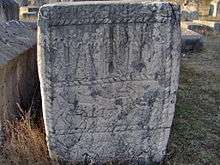
Medieval tombstones called "Stećci" (singular "Stecak") in Bosnia and Hercegovina, dating from the end of the 12th century to the 16th century, bear inscriptions and figures which look like dancers in a chain. Men and women are portrayed dancing together holding hands at shoulder level but occasionally the groups consist of only one sex.[4][5]
In Macedonia, near the town of Zletovo, the murals on the monastery of Lesnovo (Lesnovo Manastir), which date from the 14th century, show a group of young men linking arms in a round dance.[6] A chronicle from 1344 urges the people of the city of Zadar to sing and dance circle dances for a festival. However, a reference comes from Bulgaria, in a manuscript of a 14th-century sermon, which called chain dances "devilish and damned."[7]
Central Europe
The circle dance of Germany is called "Reigen"; it dates from the 10th century, and may have originated from devotional dances at early Christian festivals. Dancing around the church or a fire was frequently denounced by church authorities which only underscores how popular it was.[8][9] One of the frescos (dating from the 14th century) in Tyrol, at Runkelstein Castle, depicts Elisabeth of Poland, Queen of Hungary leading a chain dance.[10][11] Circle dances were also found in Czech Republic, dating to the 15th century. Dancing was primarily done around trees on the village green.[12] In Poland as well the earliest village dances were in circles or lines accompanied by the singing or clapping of the participants.[13]
Mediterranean
In the 14th century, Giovanni Boccaccio describes men and women circle dancing to their own singing or accompanied by musicians.[14] One of the frescos in Siena by Ambrogio Lorenzetti painted in 1338–1340 show a group of women doing a "bridge" figure while accompanied by another woman playing the tambourine.[15]
There are accounts of two western European travelers to Constantinople, the capital of the Ottoman Empire. In 1577, Salomon Schweigger describes the events at a Greek wedding:[16]
then they joined arms one upon the other, made a circle, went round the circle, with their feet stepping hard and stamping; one sang first, with the others all following after.[16]
Another traveler, the German pharmacist Reinhold Lubenau, was in Constantinople in November 1588 and reports on a Greek wedding in these terms:[17]
a company of Greeks, often of ten or more persons, stepped forth to the open place, took each other by the hand, made a round circle, and now stepped backward, now forward, sometimes went around, singing in Greek the while, sometimes stamped strongly on the ground with their feet.[17]
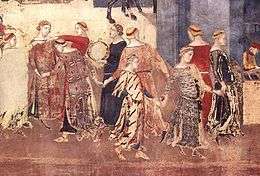 The Italian circle dance made up of females, which features the "bridge"
The Italian circle dance made up of females, which features the "bridge"- Medieval circle dancing, South Tyrol, Italy
Scandinavia
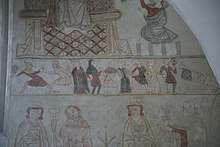
In Denmark, old ballads mention a closed circle dance which can open into a chain dance. A fresco in Ørslev church in Zealand from about 1400 shows nine people, men and women, dancing in a line. The leader and some others in the chain carry bouquets of flowers. In the case of women's dances, there may have been a man who acted as the leader.[18][19] In Sweden, medieval songs often mentioned dancing. A long chain was formed, with the leader singing the verses and setting the time while the other dancers joined in the chorus.[20]
Modern dances
Eastern Europe
Hora

The Hora dance originates in the Balkans but is also found in other countries (including Romania and Moldova). The dancers hold each other's hands and the circle spins, usually counterclockwise, as each participant follows a sequence of three steps forward and one step back. The Hora is popular during wedding celebrations and festivals, and is an essential part of the social entertainment in rural areas. In Bulgaria, it is not necessary to be in a circle; a curving line of people is also acceptable.[21]
Kolo
The Kolo is a collective folk dance common in various South Slavic regions, such as Serbia, named after the circle formed by the dancers. It is performed amongst groups of people (usually several dozen, at the very least three) holding each other's having their hands around each other's waists (ideally in a circle, hence the name). There is almost no movement above the waist.[22][23]
Southern Europe
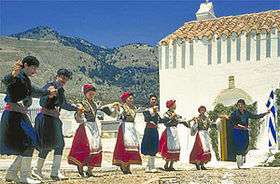
Kalamatianos
The Kalamatianos is a popular Greek folkdance throughout Greece and Cyprus, and is often performed at many social gatherings worldwide. As is the case with most Greek folk dances, it is danced in circle with a counterclockwise rotation, the dancers holding hands. The lead dancer usually holds the second dancer by a handkerchief, this allowing him or her to perform more elaborate steps and acrobatics. The steps of the Kalamatianós are the same as those of the Syrtos, but the latter is slower and more stately, its beat being a steady 4
4.[24]
Sardana
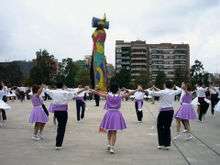
Sardana is a type of circle dance typical of Catalonia. It would usually have an experienced dancer leading the circle. The dancers hold hands throughout the dance: arms down during the curts and raised to shoulder height during the llargs. The dance was originally from the Empordà region, but started gaining popularity throughout Catalonia during the 20th century. There are two main types, the original Sardana curta (short Sardana) style and the more modern Sardana llarga (long Sardana).[25]
Syrtos
Syrtos and Kalamatianos are Greek dances done with the dancers in a curving line holding hands, facing right. The dancer at the right end of the line is the leader. The leader can also be a solo performer, improvising showy twisting skillful moves as the rest of the line does the basic step. In some parts of Syrtos, pairs of dancers hold a handkerchief from its two sides.[26][27]
Western Europe
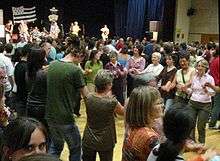
An Dro
An Dro, meaning "the turn", is a Breton circle dance. The dancers link the little fingers in a long line, swinging their arms, whilst moving to their left. The arm movements consist first of two circular motions going up and back followed by one in the opposite direction. The leader (person at the left-hand end of the line) will lead the line into a spiral or double it back on itself to form patterns on the dance floor, and allow the dancers to see each other.[28]
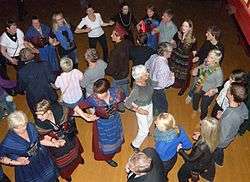
Faroese chain dance
The Faroese chain dance is the national circle dance of the Faroe Islands. The dance originated from the medieval times, which survived only in the Faroe Islands, while in other European countries it was banned by the church, due to its pagan origin. The dance is danced traditionally in a circle, but when a lot of people take part in the dance they usually let it swing around in various wobbles within the circle. The dance in itself only consists in holding each other's hands, while the dancers form a circle, dancing two steps to the left and one to the right without crossing the legs. When more and more dancers join the dance ring, the circle starts to bend and forms a new one within itself.[29]
Sacred Circle Dance
The Sacred Circle Dance was brought to the Findhorn Foundation community in Scotland by Bernhard Wosien; he presented traditional circle dances that he had gathered from across Eastern Europe.[30] Colin Harrison and David Roberts and Janet Rowan Scott took the dances to other parts of the United Kingdom where they started regular groups in south east England, then across Europe, the US and elsewhere. The network extends also to Australia, New Zealand, South Africa, South America, and India. A small centrepiece of flowers or other objects is often placed at the centre of the circle to help focus the dancers and maintain the circular shape. Much debate goes on within the sacred circle dance network about what is meant by 'sacred' in the dance.[31]
Middle East
Dabke
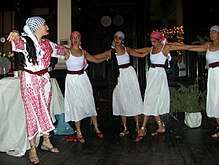
Dabke is popular in Lebanon, Syria, Palestine, Israel, Jordan and Turkey. The most famous type of the dance is the Al-Shamaliyya (الشمالية). It consists of a lawweeh (لويح) at the head of a group of men holding hands and formed in a semicircle. The lawweeh is expected to be particularly skilled in accuracy, ability to improvise, and quickness (generally light on his feet). The dancers develop a synchronized movement and step, and when the singers finish their song the lawweeh breaks from the semicircle to dance on their own. The lawweeh is the most popular and familiar form of dabke danced for happy family celebrations.[32]
Khigga
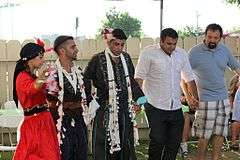
Khigga is the one of main styles of Assyrian folk dance in which multiple dancers hold each other's hands and form a line or a circle. It is usually performed at weddings and joyous occasions. Khigga is the first beat that is played in welcoming the bride and groom to the reception hall. There are multiple foot patterns that dancers perform. The head of the khigga line usually dances with an handkerchief with beads and bells added to the sides so it jingles when shaken. A decorated cane is also used at many Assyrian weddings. Moreover, the term khigga is used to denote all the Assyrian circle dances.[33]
Kochari
Kochari is an Armenian[34][35][36] and Azerbaijani folk dance, danced today by Armenians, Assyrians,[37] Azerbaijanis, Kurds, Pontic Greeks[38] and Turks.[39] Dancers form a closed circle, putting their hands on each other's shoulders. More modern forms of Kochari have added a "tremolo step," which involves shaking the whole body. In Azerbaijan, the dance consists of slow and rapid parts, and is of three variants. There is a consistent, strong double bounce. Pontic Greeks dance hand-to-shoulder and travel to the right.[40][41]
Tamzara
Tamzara is an Armenian, Assyrian, Azerbaijani and Greek folk dance native to Anatolia. There are many versions of Tamzara, with slightly different music and steps, coming from the various regions and old villages in Anatolia. Firstly they take three steps forwards, tap their left feet on the ground, and step forward to stand on the left foot; then they tale three small steps back and repeat the actions a little faster. Like most Anatolian folk dances, Tamzara is done with a large group of people with interlocked little fingers.[42]
See also
References
- Gilbert, Cecile (1974). International Folk Dance at a Glance (Second ed.). Burgess. ISBN 978-0808707271.
- "We ended with a circle dance." "A short session of circle dance was one of the activities on offer...""Archived copy" (PDF). Archived from the original (PDF) on 14 February 2012. Retrieved 24 February 2013.CS1 maint: archived copy as title (link)
- Chivers, C. J. (24 May 2006). "A Whirling Sufi Revival With Unclear Implications". The New York Times. Retrieved 22 April 2020.
Three circles of barefoot men, one ring inside another, sway to the cadence of chant. The men stamp in time as they sway, and grunt from the abdomen and throat, filling the room with a primal sound. One voice rises over the rest, singing variants of the names of God.
- Alojz Benac "Chapter XIII: Medieval Tombstones (Stećci)" in Bihalji-Merin, Otto (ed.) (1969). Art Treasures of Yugoslavia. New York: Abrams. pp. 277–296.CS1 maint: extra text: authors list (link)
- Bihalji-Merin, Otto; Benac, Alojz (1962). The Bogomils. London: Thames.
- "Historical view on the Lesnovo monastery". Ilija Velev (University of Skopje). Archived from the original on 6 July 2011. Retrieved 15 November 2010.
- Katzarova-Kukudova, Raina; Djenev, Kiril (1958). Bulgarian Folk Dances. Cambridge, Massachusetts: Slavica. p. 9.
- Goldschmidt, Aenne (1978). Handbuch des Deutschen Volktanzes. Wilhelmshaven: Heinrichshofen. p. 27.
- Fyfe, Agnes (1951). Dances of Germany. London: Max Parrish. pp. 8–9.
- Martin, György (1974). Hungarian Folk Dances. Budapest: Corvina Press. p. 17.
- "Runkelstein Castle - The illustrated castle A short history". Retrieved 14 November 2010.
- Lubinová, Mila (1949). Dances of Czechoslovakia. New York: Chanticleer Press. p. 8.
- Dziewanowska, Ada (1997). Polish Folk Dances and Songs. New York: Hippocrene. p. 26. ISBN 0-7818-0420-5.
- Nosow, Robert (1985). "Dancing the Righoletto". Journal of Musicology. 24 (3): 407–446. doi:10.1525/jm.2007.24.3.407.
- Bragaglia, Anto Giulio (1952). Danze popolari italiane [Popular Italian Dances] (in Italian). Roma: Edizioni Enal.
- Schweigger, Salomon (1964). Ein newe Reyssbeschreibung auss Teutschland nach Constantinopel und Jerusalem. Graz: Akademische Druck- u. Verlagsanstalt. p. 227.
- Lubenau, Reinhold (1915). Sahm, W. (ed.). "Beschreibung der Reisen des Reinhold Lubenau" [Account of the Journes of Reinhold Lubenau]. Mitteilungen aus der Stadtbibliothek zu Koenigsberg i. Pr. (in German). VI: 23.
- Lorenzen, Poul; Jeppesen, Jeppe (1950). Dances of Denmark. New York: Chanticleer Press. pp. 7–10.
- Curt Sachs (1963) World History of the Dance, p.263
- Salvén, Erik (1949). Dances of Sweden. London: Max Parrish. p. 8.
- "'Hora' History". forward.com. Retrieved 22 April 2020.
- Costumes. (2009). In ASKA Kolo Ansambl. Retrieved March 26, 2009, from ASKA Kolo Ansambl "Archived copy". Archived from the original on 22 February 2012. Retrieved 1 July 2014.CS1 maint: archived copy as title (link)
- kolo. (2009). In Encyclopædia Britannica. Retrieved 26 March 2009, http://www.britannica.com/EBchecked/topic/321451/kolo
- Lykesas, George H. (1993). Οι Ελληνικοί Χοροί [Greek Dances] (in Greek) (Second ed.). Thessaloniki: University Studio Press.
- "Origin of the Sardana" (in Spanish). Lavanguardia.es. 16 March 2010. Retrieved 27 July 2013.
- σύρω, Henry George Liddell, Robert Scott, A Greek-English Lexicon, on Perseus
- συρτός Henry George Liddell, Robert Scott, A Greek-English Lexicon, on Perseus
- Bacher, Elsa; Ruling, Ruth (March 1998). "An Dro Retourne" (PDF). Folk Dance Federation of California. Retrieved 4 April 2020.
- "Faroese Chain Dance". Faroe Islands.fo. Retrieved 4 April 2020.
- Watts, 2006. pages 6–10
- See many issues of Grapevine over its 25 years history, available via www.circledancenetwork.org.uk
- "Dabke: The Dance of the Lebanese Village". Sourat. Archived from the original on 18 September 2012. Retrieved 31 October 2010.
- BetBasoo, Peter Pnuel (30 April 2003). "Thirty Assyrian Folk Dances" (PDF).
- Elia, Anthony J. (2013). "Kochari (Old Armenian Folk Tune) for Solo Piano". Center for Digital Research and Scholarship at Columbia University. Retrieved 6 November 2013.
- Vvedensky, Boris, ed. (1953). Great Soviet Encyclopedia (in Russian). 23 (Second ed.). Moscow: Soviet Encyclopedia. p. 170.
КОЧАРИ — армянский народный мужской танец.
- Yuzefovich, Victor (1985). Aram Khachaturyan. New York: Sphinx Press. p. 217. ISBN 978-0823686582.
..and in the sixth scene one of the dances of the gladiators is very reminiscent of Kochari, the Armenian folk dance.
- BetBasoo, Peter Pnuel (30 April 2003). "Thirty Assyrian Folk Dances" (PDF). Assyrian International News Agency. Retrieved 6 November 2013.
- "Kotsari". Pontian.info. Archived from the original on 16 October 2012. Retrieved 6 November 2013.
- Ю.В. Келдыш, М.Г. Арановский, Л.З.Корабельникова (1990). Kochari - Musical Encyclopedic Dictionary (in Russian). Soviet Encyclopedia. p. 275.CS1 maint: multiple names: authors list (link)
- "The National Dancings". Nakhchivan Autonomous Republic. Retrieved 6 November 2013.
- Hellander, Paul (2008). Greece. Kate Armstrong, Michael Clark, Des Hannigan, Victoria Kyriakopoulos, Miriam Raphael, Andrew Ston. Lonely Planet. p. 67. ISBN 978-1741046564.
- "PontosWorld". pontosworld.com. Retrieved 22 April 2020.
Sources
Books
- Lynn Frances and Richard Bryant-Jefferies, The Sevenfold Circle: self awareness in dance, Findhorn Press (1998) ISBN 1-899171-37-1
- Marion Violets Gibson, Dancing on Water, printed in Wales (2006) ISBN 0-905285-79-4
- Matti Goldschmidt, The Bible in Israeli Folk Dances, Ed. Choros
- Judy King, The Dancing Circle, volumes 1–4, Sarsen Press, Winchester, England
- Iris J Stewart, Sacred Woman Sacred Dance: Awakening spirituality through movement and ritual, Inner Traditions, USA ISBN 0-89281-605-8
- June Watts, Circle Dancing - Celebrating the Sacred in Dance, Green Magic Publishing (2006) ISBN 0-9547230-8-2
- Bernhard Wosien, The Dancers Journey, translated from the German by Katharina Kroeber
- Maria-Gabriele Wosien, Sacred Dance: Encounter with the Gods (1986) [1974] Thames and Hudson. ISBN 0-500-81006-0
Journals
- Drumbeat, the South African circle dancing journal
- Grapevine, the quarterly journal of the sacred/circle dance network, Circle Dance Friends. ISSN 1752-4660
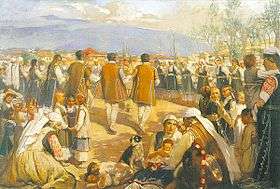
.jpg)